Introducing my new baby, a Willcox & Gibbs S200 straw plait (braid) sewing machine. Here are some pictures of the machine and interesting links to 17 Guinea, Hatlines #71, Straw hats, Alex Askaroff, Mad Hatter Blog, and how to lock a Chain Stitch.
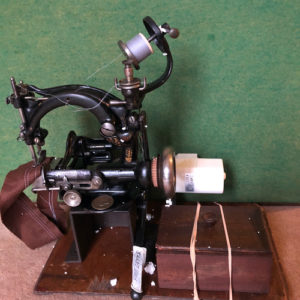
I have had two big ticket items on my millinery wish list for a while now. One is a hot block hat stretcher and the other is a Willcox & Gibbs straw sewing machine. I can now check off one of those items after winning an eBay auction a few weeks ago.
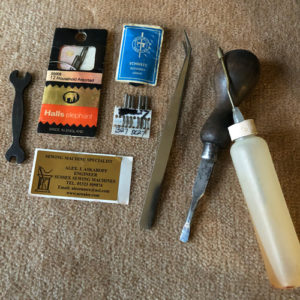
I was first introduced to the idea of a straw plait (braid) sewing machine while working at Edwina Ibbotson’s. There was one that sat in the corner with a clear upturned box covering it to protect the 17 Guinea, as she calls it, from being knocked about and keep the dust off.
I am not sure where the term 17 Guinea comes from as the Guinea was replaced by the Pound coin in 1816 and these machines are later 1800s and early 1900s. According to Wikipedia a Guinea is worth 1 Pound & 1 Shilling. The National Archives estimated the value in 1880 as equivalent £69.49 as of 2017. At the time it was worth 1 stone (6.35 kg/14 lbs) of wool or 3 days wages for skilled tradesman, which doesn’t seem like very much for a sewing machine.
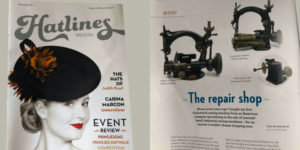
I have looked on and off over the years for a “17 Guinea” with no success. Not long ago the Hatlines magazine published by the Netherlands Hat Association, had an article about these old sewing machines. The article did a great job of showing how to clean and maintain the machines. It gave the names of several brands that I believe would fall under the name 17 Guinea and also gave me a sense of confidence in finding one.
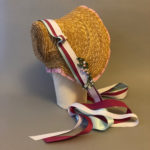
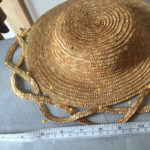
I made several straw plait hats after taking a class from Jane Smith at Morley College, London and loved the process and the results. Jane’s class taught how to make the straw hats on a standard home machine. It is a bit tricky getting around the crown, but it can be done. Ever since I’ve desired to work with a proper straw plait machine.
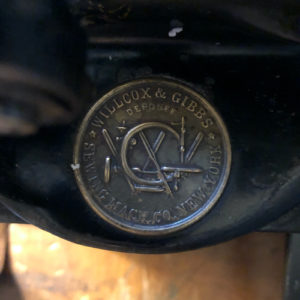
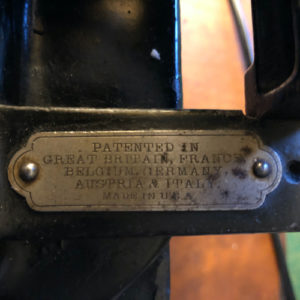
I don’t buy on eBay very often and even more rarely do I win, but I had been watching this machine and another on Gumtree. It was a Friday night and the auction ended at 8:15 pm. As the last few minutes of the auction approached, I entered my highest price, into the bidding system on eBay. It automatically bids in increments only until you are one increment above the last highest bidder, then stops. To my excitement, shock, amazement and delight. I won.
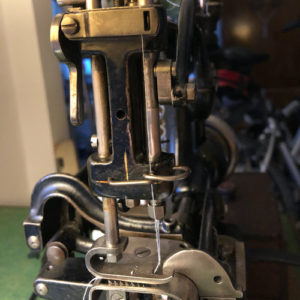
Although we have stayed very close to home in London since March, due to Covid, my husband and I adventured to Eastbourne to pick up the machine from Alex Askaroff. Followed by a stay at the Hydro Hotel. It was a good weekend.
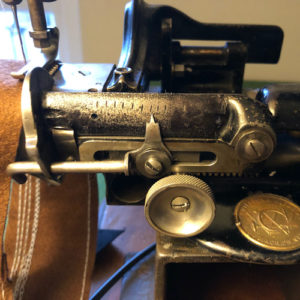
It doesn’t look like much, but the new tensioner was patented around 1875, so my understanding is that this machine was made around 1880.
The video of my machine being demonstrated by Alex Askaroff.
Alex Askaroff’s YouTube Channel has some great videos if you are interested in vintage sewing machines. I love this kind of stuff.
Another nugget was in the little wooden treasure box was a print out of the following blog post by Mad Hatter, Cristina de Prada from 18 April 2009. The link to Jane Smith’s straw hat e-book is not longer active, but she has many of the patent illustrations which I think are fascinating.
These early machine made a chain stitch, rather than a lock stitch of the current sewing machines. A chain stitch doesn’t require a separate bobbin. The underside can be used as a lovely decorative stitch but the chain stitch is know to easily unravel if you break a stitch or don’t lock the end.
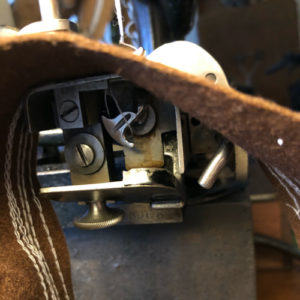
Great video on how to lock a chain stitch.
It is a different model machine but the concept is the same. Go to video at 7min 20sec for how to easily lock the chain.
Me and my “new” machine are still getting to know each other. I love the way it sews and sounds, but so far I’ve only used up a lot of thread and made a little navy blue straw plait bowl, perhaps it will become a cocktail hat. I am excited to get a bit more time with my new W&G S200.
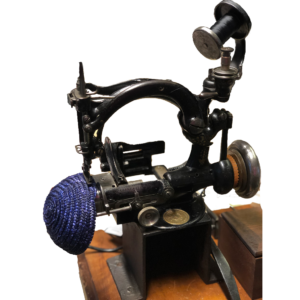


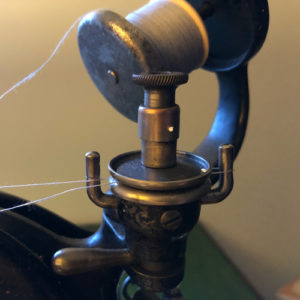
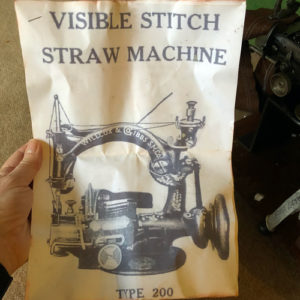
Fun machines!
But it looks like you don’t have the right presser foot for braid sewing. Does it work with that one?
MickeMechanic, To be honest I haven’t had much success with the machine yet. Can recommend a part number and perhaps where I can get it? Things have been so busy that this project has fallen to the bottom of the list, but I have grand plans for the future. Kind regards, Leanne
Sorry, I didn’t see your answer until now. You will have a hard time sewing straw braid hats with that presser foot. It will not work.
And Alex Askaroff knew that when he sold the machine. He knows a lot about sewing machines that’s for sure. But he don’t tell his customers what’s wrong with the machines he are selling. He should change his name to Alex A$$hole . He like money very much. I don’t know where you can get parts. I bought my Grossman Dresdensia on EBay Kleinanzeigen. (German craigslist).
Good luck with your hats and have fun, Mike
Une machine dans un très bel état avec une partie des outils.
Je suis chapelier et je fabrique aussi des formes à chapeaux (wood blocks).
Effectivement le pied de biche ne permet pas de bien coudre la tresse de paille. En France il y a une adresse pour ça :
Alies Thierry (réparation machine à coudre)
21 Rue Henri Marre, 82000 Montauban
05 63 91 54 91
Je pense qu’ils ont cette pièce.
Vous pouvez aussi coudre de la soutache de laine ou de coton.
Je sais ce que c’est de chercher et trouver des outils anciens.
Amusez vous bien avec ce petit bijoux.
Hello Tessier, Thank you so much for your post with contact information for Alies Thierry and the info about being able to use the machine for other types of material.
Cheers,
Leanne
Here is Tessier’s post in English thanks to Google Translate:
A machine in very good condition with some of the tools.
I am a hatter and I also make hat forms (wood blocks).
In fact, the presser foot does not allow you to sew the straw braid properly. In France there is an address for that:
Alies Thierry (sewing machine repair)
21 Rue Henri Marre, 82000 Montauban
05 63 91 54 91
I think they have this piece.
You can also sew wool or cotton soutache.
I know what it’s like to look for and find old tools.
Have fun with this little gem.